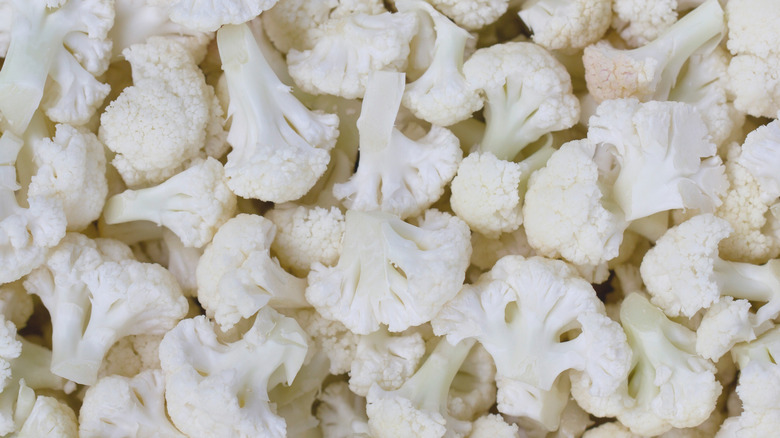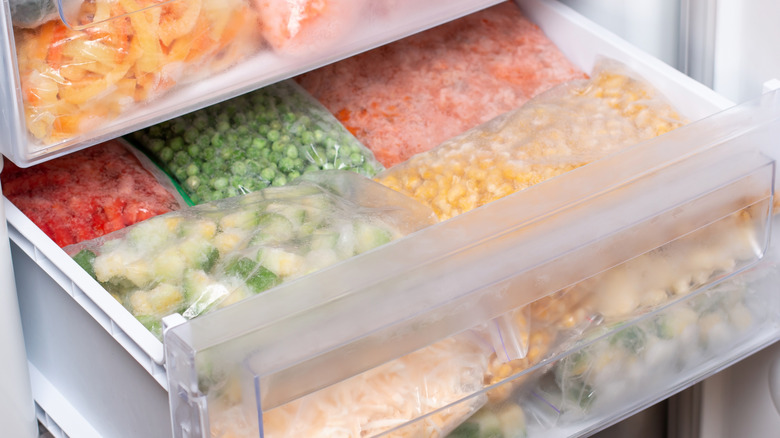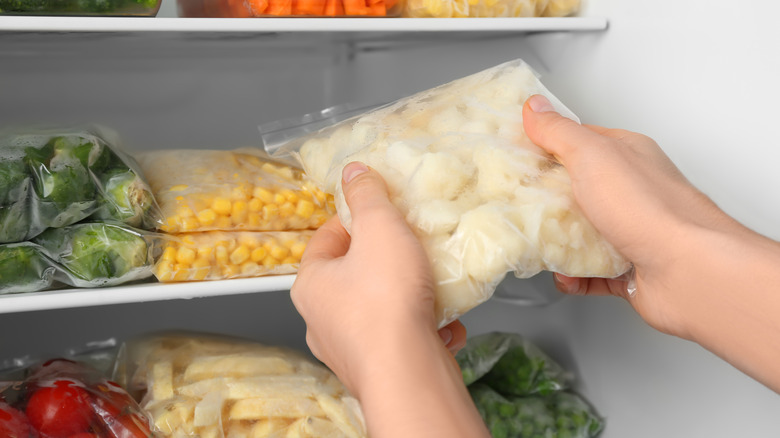The Absolute Best Ways To Store Cauliflower
Forget broccoli. Cauliflower is in — seriously. Once dismissed as a bland, generic vegetable, cauliflower has undergone a transformation in recent years. According to Martha Stewart, cauliflower is the newest low-carb fad for adults. It has become the healthier, creative foundation for comfort foods like vegetarian General Tso's and cheesy au gratin, and tastes just as delicious grilled as it does with a dipping sauce. In fact, cauliflower has undergone such a resurgence that in 2017, Time Magazine hailed it an "It" vegetable.
So long, vegetable monotony.
However, no amount of status — or recipe versatility — can revive a cauliflower back from the grave. Fresh cauliflower typically lasts anywhere from one to three weeks, while cooked cauliflower maxes out at 10 days in the fridge (via Eat By Date). Once the vegetable has gone bad, it's a lost cause. That's why learning how to properly store your cauliflower is a skill well worth your time.
Every vegetable comes with its own storage technique, from protecting root vegetables in a paper bag to keeping tomatoes on the counter. Keeping cauliflower fresh requires similar strategizing, and with a few, simple hacks, you'll keep your veggies on deck until culinary inspiration strikes next.
Protect cauliflower in a plastic bag or an airtight container
To ensure longevity, keep cauliflower whole, unwashed, and well-protected.
"A whole head of broccoli or cauliflower will do well in a plastic bag in the fridge," says North Carolina chef John May.
Indeed, plastic bags are typically the easiest storage technique, as cauliflower often comes wrapped in plastic. It's not a bad idea to simply pop the vegetable inside the crisper drawer of your refrigerator, away from other fruits, says Food Network. Fair warning not to wrap your cauliflower too tightly; it needs room to breathe within the bag. If you prefer Tupperware or sealed containers over plastic wrap, those get the job done, too. For best results, you'll also want to store cauliflower stem-up, says Eating Well.
As for home cooks itching to cut their cauliflower ahead of time, Masterclass gives the go-ahead. Just make sure to dry florets on a paper towel before transferring to a container. Discouraging such moisture is non-negotiable. Excess water can turn cruciferous vegetables mushy, so when you do put your cauliflower away, avoid washing. According to Steamy Kitchen, cruciferous vegetables shouldn't actually be washed until the moment you're ready to eat them.
Pop florets in the freezer to extend their lifespan
If you have a surplus of cauliflower you're not planning to use immediately, save it for a rainy day. You never know when you'll have a cauliflower craving or have to whip up a last-minute crowd pleaser.
According to Pantry Tips, cauliflower can last for about eight months in the freezer. An entire cauliflower lasts longer than one that's been cut or cooked, so plan your meal ahead of time to ensure you're getting the freshest results.
As for freezing logistics, chop cauliflower into florets and blanch, recommends Mccormick. Blanching requires steeping cauliflower in boiling water for about three minutes and subsequently cooling it down in an ice bath. According to BBC Good Food, blanching preserves the vegetable's taste, texture, and nutrients prior to freezing. If you skip this step, it's okay to finely chop florets and then freeze. You'll just want to consume your cauliflower within a few weeks — and in cooked form.
Once you've blanched your florets, seal them in a freezer-safe container, or let them freeze on a baking tray. Taste of Home suggests freezing florets individually before putting them in a plastic bag to avoid clumps of cauliflower. This way, you'll ensure your cauliflower is good to go the next time you need it ... but who knows? With a longer lifespan, your cauliflower may very well still be in the freezer when the next "It" vegetable takes its place.


